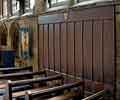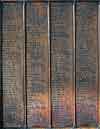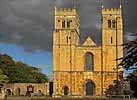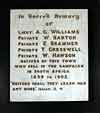For this church:    |
| |||||||||||||||||||||||||||||||||||||||||||||||||||||||||||||||||||||||||||||||||||||||||||||||||||||||||||||||||||
| In Sacred Memory of LIEUT: A. G. WILLIAMS PRIVATE W. BARTON PRIVATE E. BRAMMER PRIVATE T. CRESSWELL PRIVATE W. HAWSON NATIVES OF THIS TOWN WHO FELL IN THE CAMPAIGN IN SOUTH AFRICA 1899 TO 1902. “NEITHER SHALL THEY LEARN WAR ANY MORE”. ISAIAH, II, 4. |
World War I memorial
 Oak panelled Oak panelled war memorial |
 Detail of memorial Detail of memorial |
The Lady Chapel was restored in in memory of 'the men of the old parish of Worksop who fell in the Great War, 1914-1918.' The names of the 457 fallen were carved on oak panels by Thomas Pepper and are listed by regiment in ten columns.
A full transcript of the memorial can be downloaded from this website. Further information on the men listed can be found on the Nottinghamshire Great War Roll of Honour website.
All their stories are poignant but only a few can be mentioned here, for reasons of length. The ages of the soldiers and sailors at their deaths are given in brackets.
Of the 11 Worksop men belonging to the Navy, three – Able Seamen Arthur Beldham (22), Alfred Earnest Collier (30) and Joseph Keight (37) – died in HMS Good Hope, which was sunk with all 915 hands early in the war, when the crew would not have been fully trained. The Good Hope was sunk by SMS Scharnhorst and SMS Gneisenau off the coast of Chile during the Battle of Coronel on 1 November 1914. The German cruisers were sunk by a larger British squadron off the Falklands a few weeks later.
Almost all the men listed on the memorial – over 98% – were from the ranks, but of the few officers who lost their lives – and one of the earliest casualties of the war – was a member of the Foljambe family of Osberton. Major Hubert Francis Fitzwilliam Brabazon Foljambe (42) of the Kings Royal Rifle Corps had served in the South African war and at the beginning of the Great War was part of the first Expeditionary Force in August 1914. He served through the Mons retreat, and was killed in action on the Aisne on 14 September.
The Sherwood Foresters lost 167 men from the ‘old parish’ of Worksop, of whom only two were officers. One of these was Lieutenant Henry Daffen (22), the son of a local solicitor, who due to the illness of his Captain, happened to be in command of his company at the time of the Irish Easter Rising. Companies of the Sherwood Foresters were amongst the first troops to arrive in Ireland, and they played a prominent role in supressing the uprising, losing 31 men. Lieutenant Daffen was killed on 26 April 1916, and Private John Robert Forth (18) of Marescroft also lost his life in the fighting on the Northumberland Road, dying of his wounds the day after Lieutenant Daffen lost his life. Both are buried in Grangegorman Military Cemetery, Dublin.
A number of local families lost more than one son during the Great War. Bombardier Harry Hibberd (23), a regular soldier in the Royal Field Artillery, was, like Major Foljambe, part of the Expeditionary Force, and he also lost his life after Mons, at La Bassee. His elder brother Private Tom Hibberd (28) had been a miner, and volunteered in September 1914. He joined the South Staffordshire Regiment and was attached to the Machine Gun Section. He died in France the day after receiving a wound in the leg, on 18th November 1915.
Towards the end of the war, the Kelk family shared the same fate as the Hibberds. Frederick (24) and Albert (21) Kelk were the sons of William and Annie Kelk, natives of Worksop. They had joined up together in 1916 and Fred had been drafted into the Royal Field Artillery with whom he saw service at Salonica, where he was wounded, before being transferred to the Western Front. He was wounded again on 2 September 1918 and brought back to England, dying at the military hospital in Didsbury on 21st September. His younger brother Albert had joined the Sherwood Foresters and spent the war on the Western Front, being wounded in October 1917. He rejoined his regiment on August 14th 1918, and was killed in action on 19th September, two days before his brother died of his wounds.
Of those commemorated on the Pepper memorial, the most highly decorated were two men from the ranks, who were awarded the Distinguished Conduct Medal for conspicuous gallantry under fire. Private J Stout (22) of the Lincolnshire Regiment, was awarded the DCM whilst serving in Salonica in 1916. Thereafter he served in France, losing his life whilst trying to rescue a wounded officer, on 2 April 1918. Sergeant Frederick Sorby (29) was a merchant seaman who joined up at the outbreak of war whilst in Canada, and was transferred to the Black Watch Canadian Expeditionary Force. He served through the war, being awarded the DCM and Bar, and eventually losing his life on 9 October 1918, fighting in northern France.
Two officers, Lieutenants H E Hodding (26) of the Sherwood Foresters and F C Vessay (29) of the Royal Garrison Artillery, received the Military Cross. Lieutenant Vessay had been promoted from the ranks in June 1918 and had been a member of the Priory Church choir in his youth. Both lieutenants died towards the end of the war, Lieutenant Vessay on 17 September 1918, and Lieutenant Hodding on 8 November 1918. Both died having been gassed.
Perhaps the most sadly mourned death at the Priory Church was that of the Revd C H Garrett (28), who had been assistant priest there since 1911, before joining the Army Chaplain’s Department in February 1917. He met his death on 26 September 1917 whilst with the 2nd/6th Battalion of the South Staffordshire Regiment. The Worksop Guardian reported that ‘in the recent fighting Mr Garrett accompanied the doctor in the advance which the troops to which he was attached was about to make. The objective in view was a dug-out, or German ‘pill box’ and this, after heavy fighting, was captured. By some chance the doctor was taken prisoner, and Mr Garret remained in the captured position with the lads who were holding it against the foe. His presence, he no doubt thought, would cheer them, and he could at least help to bind up their wounds and pray with them in the hour of death. A change this from the quiet Solemnity of the Priory Church which he loved so well, and along the vaulted aisles of which his rich voice had so often rolled in waves of sacred song. The Germans continued to shell the position in the hope of driving out the British, and one can hardly imagine the horror of it all – the noise of the bursting shells and all the fearful sounds of the battlefield. Calmly and composedly the Chaplain stuck to it along with the boys – one of whom he had known in happier days – until a shell burst right in their midst, and he fell mortally wounded. He died afterwards whilst being conveyed to the advanced dressing station’.
World War I memorial (Manton Pit)
There is a further memorial in the Lady Chapel, taken from Manton Pit when it closed down. Many of the deceased are also listed on the Pepper Memorial, since they haled from the ‘old parish’ of the Priory Church. Cast in brass, with a surround of oak leaves, the Manton Pit memorial reads:

|
|||||||||||||||||||||||||||||||||||||||||||||||||||||||||||||||||||||||||||||||||||||||||||||||||||||||||||||||
Amongst those listed as ‘Honoured’ on the Manton Pit memorial is one of only six Nottinghamshire-born soldiers to be awarded the Victoria Cross, namely Sergeant William Johnson VC of the 5th Battalion Sherwood Foresters, who was a miner before the war and part of the bell-ringing team at the Priory Church – a role in which he continued after the war. His V.C. citation reads: ‘For most conspicuous bravery at Ramicourt on 3rd October, 1918. When his Platoon was held up by a nest of enemy machine guns at very close range Sgt. Johnson worked his way forward under very heavy fire, and single-handedly charged the post, bayoneting several gunners and capturing two machine guns. During this attack he was severely wounded by a bomb, but continued to lead forward his men. Shortly afterwards, the line was once more held up by machine guns. Again he rushed forwards and attacked the post single-handed. With wonderful courage he bombed the garrison, put the guns out of action, and captured the teams. He showed throughout the most exceptional gallantry and devotion to duty’. Sergeant Johnson survived the War although he was unable to work underground again.
There is no memorial to the dead of World War II in the Priory Church. Their names are listed on the Cenotaph on Memorial Avenue.







